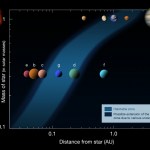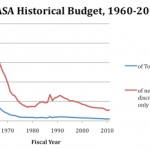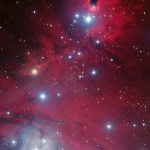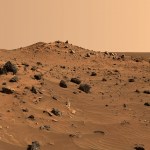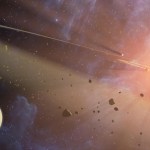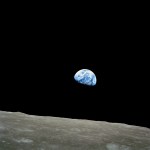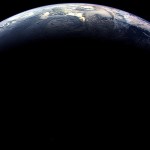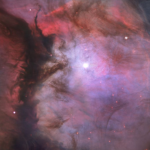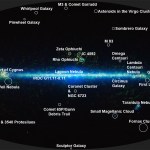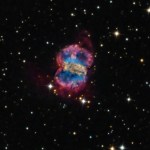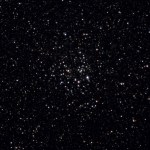Astronomy
“I’m sure the universe is full of intelligent life. It’s just been too intelligent to come here.” -Arthur C. Clarke
For the past three years, Kepler has been looking at 150,000 stars, searching for planetary transits.
Image credit: NASA.
The science haul has been huge, but mostly larger planets close in to their parent stars. Nevertheless, a few rocky, habitable-zone planets have been discovered. Whether we take optimistic or pessimistic estimates, what do we expect for the rest of the galaxy?
Image credit: NASA / JPL-Caltech / Wikimedia Commons user Henrykus.
At minimum, some 6 billion…
“This Administration has never really faced up to where we are going in space… As a result, NASA is both drifting and lobbying for bigger things — without being able to focus realistically on what it should be doing.”
-White House staff assistant Clay Thomas Whitehead, February 1971
What should we be doing with respect to our space program? At its peak -- the mid-1960s -- the US government spent somewhere around 20% of its non-military discretionary spending on NASA and space science/exploration. Today?
Image credit: OMB Historical Budget Tables.
That number is down to 3%, the lowest it's…
“Men occasionally stumble over the truth, but most of them pick themselves up and hurry off as if nothing had happened.” -Winston Churchill
There was a piece that ran over this weekend in the Wall Street Journal, claiming that the lack of evidence for extraterrestrial life is actually evidence pointing towards the existence of God.
Image credit: NASA/Ames/JPL-Caltech, via http://kepler.arc.nasa.gov/news/nasakeplernews/index.cfm?FuseAction=Sho….
Does this argument hold any water? If we want to scrutinize it (for real), there are three questions we should be asking ourselves:
What are,…
“Bethany: Is your house on fire, Clark?
Clark: No, Aunt Bethany, those are the Christmas lights.” -National Lampoon’s Christmas Vacation
With Christmas upon us, what would you ask for from the Universe? It can't bring you tangible presents, perhaps, but it can bring you the greatest cosmic sights you've ever feasted upon.
Image credit: Flickr user Alicia, via https://www.flickr.com/photos/capella_891/2779209611/.
So why not learn how to find the Christmas Tree Cluster, and enjoy the greatest astrophotography efforts of it, all in the form of a Christmas poem?
Image credit: European…
“It is always the simple that produces the marvelous.” -Amelia Barr
All things being equal, the simplest explanation is usually the best. At least, that's how Occam's razor is most commonly phrased these days. Yet, when it comes to the headlines -- whether it's a "discovery" of dark matter or "evidence" for life on Mars -- you have to wonder what "simple" actually means.
Image credit: NASA / JPL-Caltech / SAM-GSFC / Univ. of Michigan.
The answer isn't what most people suspect, and it shouldn't really be up for debate. If you want to hypothesize that something novel is occurring, something…
“When you look at the stars and the galaxy, you feel that you are not just from any particular piece of land, but from the solar system.” -Kalpana Chawla
Two weeks ago, we released the first video in our web series: Genesis, the story of where all this comes from.
The video was on Organic Molecules, and while it hasn't exactly gone viral (yet), the like/dislike ratio is pretty hard to beat.
Well, it's time for Episode 2, on the topic of the Solar System. Head on over to Medium to watch the whole thing, along with an official transcript as well!
“In the depth of winter I finally learned that there was in me an invincible summer.” -Albert Camus
This Sunday marks the Winter Solstice: the darkest, longest evening of the year for all the Earth's northern hemisphere denizens.
Image credit: Ken Tape, of the Winter Solstice at Fairbanks, Alaska.
Sure, you probably know all about Earth's axial tilt and how the southern hemisphere experiences the summer solstice at the same time, but here are a few solstice facts that you might not know, including what it means for the Moon, for new year's celebrations, and for our history of venturing…
“Men of genius are often dull and inert in society; as the blazing meteor, when it descends to earth, is only a stone.” -Henry Wadsworth Longfellow
Sure, sure, and they're not even big, impressive stones. But like any real estate agent will tell you, location is everything.
Image credit: NASA / JPL-Caltech / W. Reach (SSC/Caltech).
And when your tiny, pebble-sized stone originates from an asteroid that crosses Earth's orbit and leaves a debris trail behind, that "only a stone" can appear as so much more.
Image credit: Stéphane Guisard (Los Cielos de America), TWAN, via http://apod.nasa.…
“Mars once was wet and fertile. It’s now bone dry. Something bad happened on Mars. I want to know what happened on Mars so that we may prevent it from happening here on Earth.” -Neil deGrasse Tyson
No, what happened on Mars isn't in any danger of happening here on Earth, despite what your sci-fi horror films might have you believe. We're a long way from becoming a dry, cold, barren desert wasteland like our neighboring world.
Image credit: NASA / Viking Orbiter.
But just because we're not in danger of that doesn't mean that it isn't vitally important to understand what exactly happened on…
“We live in an atmosphere of shame. We are ashamed of everything that is real about us; ashamed of ourselves, of our relatives, of our incomes, of our accents, of our opinions, of our experience, just as we are ashamed of our naked skins.” -George Bernard Shaw
And despite all of that, when we pause and look around at all the good things we have -- which hopefully many of us will be doing at some point today -- we'll find something remarkable that we all have to be thankful for: the very Universe and our shared cosmic history that enabled us all to be here!
Image credit: NASA, ESA, Hubble…
“We… are what happens when a primordial mixture of hydrogen and helium evolves for so long that it begins to ask where it came from.” -Jill Tarter
But that doesn't mean we can't also look to the hydrogen itself, and use its information to learn about where other things may have come from!
Image credit: Lionel BRET/EUROLIOS.
An extraordinary example of this -- including what's possible, if not yet practical -- comes from looking at the 21-cm emission line of hydrogen, a forbidden transition with the smallest inherent line width of all!
Images credit: R Nave of Hyperphysics from…
“Be not afraid of greatness. Some are born great, some achieve greatness, and others have greatness thrust upon them.” -William Shakespeare
But in the case of Orion, it's great because of not only how it was born, but where and when: recently, and so close to us! And that makes our views of not only the main nebula fantastic, but also of its smaller companion.
Image credit: Wikimedia Commons user RawAstroData, via http://www.rawastrodata.com/dso.php?type=nebulae&id=m42.
It's all part of the great Orion molecular cloud complex, but somehow the smaller region illuminated by a single…
“I am undecided whether or not the Milky Way is but one of countless others all of which form an entire system. Perhaps the light from these infinitely distant galaxies is so faint that we cannot see them.” -Johann Lambert
There's a problem with our view of the night sky: beautiful though it is, we're incapable of seeing with our own eyes what the Universe is like from an outsider's perspective. No matter where we are, we're stuck inside our own galaxy, with all its light-blocking and obscuring properties.
Image credit: Richard Payne, of Arizona Astrophotography.
But there's a…
“Derive happiness in oneself from a good day’s work, from illuminating the fog that surrounds us.” -Henri Matisse
But the surrounding fog might not come from our minds nor from our world, but rather from the plane of the galaxy itself. Nevertheless, the brightest clusters -- the ones placed serendipitously -- are clearly visible (and quite spectacular) from our vantage point here on Earth.
Image credit: Messier 35 by Jorge Garcia, via http://www.pbase.com/image/91887467.
One of my favorites, and one of the greatest views of a star cluster offered to skywatchers everywhere during…
“I must trust that the little bit of love that I sow now will bear many fruits, here in this world and the life to come.” -Henri Nouwen
So, maybe you've been living under a rock, but whether you have or haven't, the news is still amazing: we've just landed on our first not-a-rock in space, but rather the remnants of an icy world from our Solar System's early moments of formation.
Image credit: ESA / CNES / Philae, via https://twitter.com/ObservingSpace/status/532596055783661568/photo/1.
That's right, for the first time ever, we've landed a manmade probe on a comet, and are now…
“If there is nothing new under the sun, at least the sun itself is always new, always re-creating itself out of its own inexhaustible fire.” -Michael Sims
It takes the death of old stars to create the newer generations of stars in the Universe, and it's through the very act of that stellar death that "interesting" material finds its way into the Universe. This way, the subsequent generations of star systems will have more heavy elements, more rocky planets, more complex chemistry, and -- in the end -- more opportunities for life.
Image credit: J-P Metsavainio, via http://astroanarchy.…
“It is not when truth is dirty, but when it is shallow, that the lover of knowledge is reluctant to step into its waters.” -Friedrich Nietzsche
Out beyond Neptune, the last of our Solar System's gas giants, the icy graveyard of failed planetesimals lurks: the Kuiper Belt. Among these mixes of ice, snow, dust and rock are a number of worlds -- possibly a few hundred -- massive enough to pull themselves into hydrostatic equilibrium.
Image credit: Wikimedia Commons user Lexicon; modified from the NASA original.
The most famous among them are Pluto, the first one ever discovered, and Eris, of…
“Things need not have happened to be true. Tales and adventures are the shadow truths that will endure when mere facts are dust and ashes and forgotten.” -Neil Gaiman
When you consider the short life of a star cluster -- from a collapsing molecular cloud to a nebula rich in gas and dust to a bright cluster of shining stars until the time it dissociates -- you might think that they'd all be the same, except for a few details like mass and density profile. But then how would you explain this object?
Image credit: John C. Mirtle of http://www.astrofoto.ca/john/m026.htm.
Here's a cluster, 89…
“You cannot be lonely if you like the person you’re alone with.” -Wayne Dyer
We like to think of our Solar System as typical: a central star with a number of planets -- some gas giants and some rocky worlds -- in orbit around it. Yes, there's some variety, with binary or trinary star systems and huge variance in the masses of the central star being common ones, but from a planetary point of view, our Solar System is a rarity.
Image credit: NASA / JPL-Caltech.
Because even though there are hundreds of billions of stars in our galaxy for planets to orbit, there are most likely around a…
“Let others praise ancient times; I am glad I was born in these.” -Ovid
With all that we know of astronomy, with the hundreds of billions of galaxies and hundreds of billions of stars in each that we know are there, it might surprise you to learn that the stars -- for the most part -- don't segregate themselves by age, but rather live together in well-mixed populations.
Image credit: European Southern Observatory’s Very Large Telescope, of Planetary Nebula IC 1295.
So how, then could we possibly hope to find the oldest stars that are out there? Believe it or not, we have more than just a…
